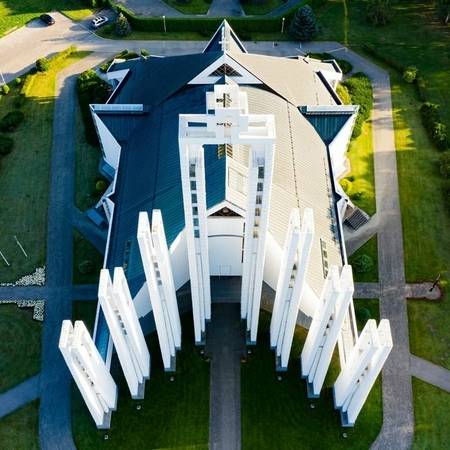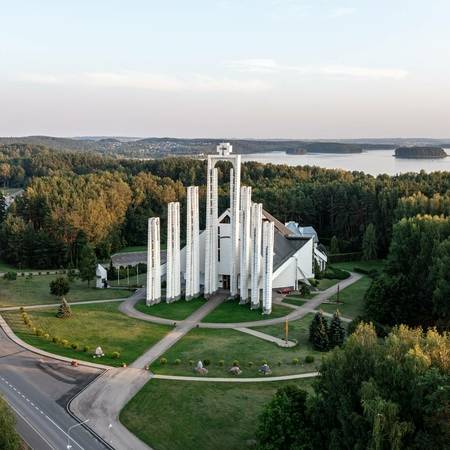Elektrėnai St. Virgin Mary Queen of Martyrs Church is located in the city of Elektrėnai, near the Vilnius-Kaunas highway, almost halfway between these cities, 10 km west of Vievis. Next to the future Lithuanian power plant, in 1960, construction of an energy settlement began on the northern shore of Lake Pukinas. In 1962, this settlement was named Elektrėnai, it was granted city rights, and in 2000 it became the center of the municipality.
- During the Soviet occupation, no one even dreamed of building a church, although many exiles who had returned from Russia settled in Elektrėnai, who maintained their national values and the Catholic faith in exile. At that time, believers from Elektrėnai traveled to the neighboring parishes of Vievis, Kietaviškės, and Semeliškės.
- When the revival began, in the autumn of 1988, about 2 thousand signatures were collected for a petition to establish a parish and build a church in Elektrėnai. In the summer of 1989, Father Jonas Sabaliauskas was appointed the first pastor of Elektrėnai, although formally the new parish, which included only the city of Elektrėnai, was established in early 1990.
- The first Holy Mass was celebrated in the Elektrėnai canteen hall, later temporary prayer rooms were set up in the hall on the second floor of the Utility Complex. In 1990, construction of the prayer house began. The HK Šilgalis project was chosen (designers: H. Karvelis, G. Chomičius, V. Zanevičius, A. Glagolevas).
- On June 30, 1990, Bishop Juozapas Matulaitis of Kaišiadorys consecrated the cornerstone of the future church. On July 28, 1996, the sanctuary was solemnly consecrated in the presence of the Apostolic Nuncio to Lithuania, Archbishop Justo Mullor Garcia.
- The church of modern architecture, rising in the monotonous city skyline, has become a symbol of Elektrėnai. The highlight of the church's exterior is a semicircular portal, which consists of a rectangular arch with a cross and six vertical cross-sections. The majestic portal depicts the seventh century of Christianity in Lithuania.
- The interior space of the building is covered with a cylindrical vault, which passes through stylized triangular lunettes, resting on irregular columns, half-columns with stepped capitals. The apse and side chapels are volumes of broken shapes, illuminated by natural light flowing through windows and skylights. The church ceiling is decorated with rectangular decorative panels similar to the Roman Pantheon.
The most visible part of the church is the sculpture of the “Risen Christ” placed in the apse, created in 1996 by sculptor Stanislovas Kuzma. On the left side, in the chapel, on a stepped pedestal stands another work by this sculptor, dedicated to the church’s title – “Holy Virgin Mary, Queen of Martyrs”. This sculpture embodies the piety, loyalty and gratitude of the Lithuanian people, who have walked the path of suffering, to Mary, the Mother of God. The “Way of the Cross” by artist Nijolė Vilutytė, made in graphite technique, is composed on a wavy wall, which resembles an unrolled shroud. Four crosses with the symbols of the evangelists, created after the opposite ones by the same artist, are incorporated into the walls. These crosses mark the places where the holy oil of Chrism was applied during the church’s consecration ceremony. On the right side of the church, in the chapel, hang 4 church procession flags woven by textile artist Jonė Strigūnaitė-Paulauskienė: the Blessed Virgin Mary, St. Joseph, St. John the Baptist, and St. Casimir.





Reviews